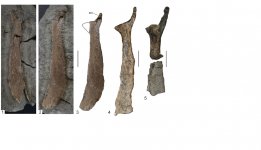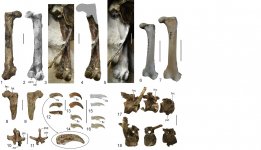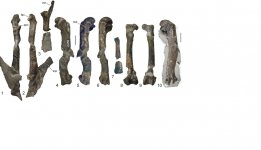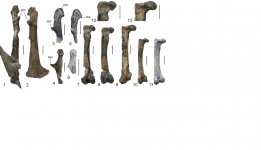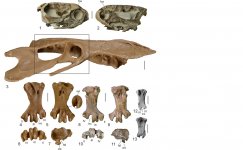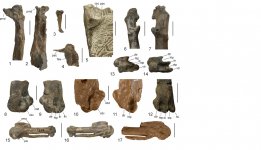Gen. indet. sp. indet. A (cf. Klallamornis or Olympidytes)
2002 Plotopteridae, new species?; Goedert and Cornish, p. 67, figs. 3b, 4b, 5d.
2011 Tonsala buchanani (in part); Dyke, Wang, and Habib, p. 2, figs. 2G–J, 2M, 2P–Q, 2U–V.
2018 “Tonsala” buchanani; Mayr and Goedert, fig. 2D.
2021 Plotopteridae, unidentified species; Mayr et al., p. 2,
fig. 3a.
Description and comparisons.—UWBM 86871 is the only plotopterid in which the humerus, coracoid, and femur of a single individual are preserved in their entire length. As such, the specimen is of significance for an assessment of the limb proportions of plotopterids, even though all three bones are broken in two or more parts that were shifted apart owing to tectonic movements during the fossilization process.
UWBM 86871 includes the cranial extremity of the left scapula, which has been freed of matrix, with a portion of the scapular blade still being appressed to the sternal end of the coracoid. The scapula was mentioned by Goedert and Cornish (2002) but not by Dyke et al. (2011), who stated that the bone is known only from the T. hildegardae holotype. As in other plotopterids, the scapula of UWBM 86871 has a very long acromion, which forms a sharper angle with the cranial margin of the bone than in T. hildegardae, in which the base of the acromion smoothly merges into the cranial margin of the scapula (Fig. 1.4, 1.5). The acromion of UWBM 86871 is less ventrally deflected than in a plotopterid from Japan (Ando and Fukata, 2018). The bone appears to be slightly larger than the scapula we refer to T. hildegardae in the present study (SMF Av 662; see the preceding notes). Dyke et al. (2011, p. 2) stated that the coracoid of UWBM 86871 consists of the “cranial [sic] end […] broken at the level of the sternocoracoid impression,” but the bone is completely preserved. The UWBM 86871 coracoid (Fig. 4.1) is distinctly smaller than the coracoid that was referred to Klallamornis
abyssa (Fig. 4.2) by Mayr and Goedert (2016). The fossil differs from the coracoid of the Tonsala hildegardae holotype in that the facies articularis clavicularis does not form a pronounced hook. It is distinguished from the coracoid SMF Av 614, which was referred to Tonsala sp. by Mayr and Goedert (2016), in that the processus procoracoideus more strongly points in the omal direction. The sternal extremity of UWBM 86871 is too poorly preserved for close comparison with other plotopterids. Apart from being smaller, the coracoid of UWBM 86871 resembles that of the recently described Stenornis kanmonensis Ohashi and Hasegawa, 2020 from the early
Oligocene of Japan (Ohashi and Hasegawa, 2020). However, since the coracoids of other similar-sized taxa, such as Olympidytes thieli, are unknown, it is not possible to assess the phylogenetic significance of this resemblance. Ohashi and Hasegawa (2020, p. 288) did not list measurements for the length of the Stenornis kanmonensis coracoid but noted that “the size is almost the same as Copepteryx hexeris,” for which the length of the coracoid was given as 180 mm by Olson and Hasegawa (1996). With an estimated length of ∼150 mm, the coracoid of UWBM 86871 is distinctly shorter.
The humerus of UWBM 86871 and the referred humerus SMF Av 650 are the only completely preserved humeri of plotopterids from the Olympic Peninsula discovered so far. The shaft of the bone shows a marked sigmoid curvature, which is characteristic of the plotopterid humerus. It is more slender than the humerus shaft of Copepteryx hexeris Olson and Hasegawa, 1996, the only other plotopterid species for which a complete humerus is known. The shaft is not as strongly bulging dorsally as it is in the T. hildegardae holotype, a condition that was considered of pathologic origin by Olson (1980). The distal end of the bone resembles the humerus of T. hildegardae in the dorsoventrally narrow process flexorius. As detailed by Goedert and Cornish (2002), however, the trochlear ridges are better developed than in the T. hildegardae holotype.
The ulna (Fig. 3.7) is broken in two portions and lacks the intermediate section. The proximal end of this bone was previously illustrated by Dyke et al. (2011, fig. 2M) but misidentified as the proximal radius. As far as comparisons are possible, the preserved portions of the bone resemble the ulna of T. hildegardae (Olson, 1980; Mayr et al., 2015).
Dyke et al. (2011, p. 2) stated that the femur of UWBM 86871 was “glued together in the UWBM collection back-tofront.” However, and as noted by Mayr and Goedert (2016), the bone has merely been freed from surrounding rock and is in the same state it was in the original matrix.
Material.—UWBM 86871: partial skeleton including the left coracoid, left scapula, left humerus (erroneously stated to be from the right side by Dyke et al., 2011, p. 2 but correctly labeled as a left humerus by Dyke et al., 2011, fig. 2I–J; Dyke et al., 2011 also listed the distal end of a left humerus, but UWBM 86871 includes only the left humerus, which is complete), partial left ulna (erroneously identified as the radius by Dyke et al., 2011), and left femur; from the Jansen Creek Member of the Makah Formation, southeast of Bullman Creek. SMF Av 650: right humerus (Fig. 3.10); from the Jansen Creek Member of the Makah Formation, approximately 200 meters west of the mouth of Rasmussen Creek; collected by JLG on 27 December 1986. The Jansen Creek Member is an olistostrome and latest Eocene to earliest Oligocene in age.
Measurements.—UWBM 86871: humerus, length as preserved, 143.8 mm (Dyke et al., 2011, table 1), distal depth, 16.1 mm; coracoid, length as preserved, ∼150 mm; femur, length as preserved, 133.0 mm (Dyke et al., 2011, table 1 erroneously listed the femur measurements for UWBM 86870, which is an isolated tarsometatarsus). SMF Av 650: humerus, maximum length along longitudinal axis, 136.0 mm; width of shaft in midsection, 20.0 mm; maximum proximal width, 33.0 mm; maximum distal width, 28.6 mm.
Remarks.—UWBM 86871 was referred to Klallamornis buchanani by Dyke et al. (2011) and is much more complete than the holotype of this species. As preserved, the length of the femur of UWBM 86871 is subequal to that of the K. buchanani holotype (135.1 versus 133.0 mm; Fig. 4.7, 4.9), but the bone is broken in the distal section of the shaft, and the two portions are shifted apart by some distance. It was, therefore, originally shorter than the femur of the Klallamornis buchanani holotype (Fig. 4.8), from which it also differs in having a narrower proximal end (28.3 versus 33mm; Fig. 4.12, 4.13). The condylus lateralis of UWBM 86871 is furthermore narrower than that of the K. buchanani holotype.
Apart from being larger, UWBM86871 differs from Tonsala hildegardae in the shape of the processus acrocoracoideus of the coracoid, which has a bulkier tip and forms a less-pronounced hook (Fig. 4.3, 4.5); the acromion of the scapula forms a sharper angle with the cranial margin of the bone (Fig. 1.4, 1.5); the shaft of the femur is stouter than in T. hildegardae.
UWBM 86871 is distinctly smaller than specimens assigned to Klallamornis abyssa, and the femur is longer than that of the Olympidytes thieli holotype (Fig. 4.11). A well-founded assignment to Klallamornis or Olympidytes, or a delimitation from either taxon is, however, not possible currently.
Fred
Figure 3. (1–9) Major bones of the plotopterid specimen UWBM 86871 from the Makah Formation (gen. indet. sp. indet. A), which was previously assigned to, and in part used to diagnose (incorrectly), Tonsala buchanani by Dyke et al. (2011). (1, 2) Left coracoid: (1) dorsal view; (2) ventral view. (3) Cranial portion of the left scapula in lateral view. (4–6) Left humerus: (4) cranial view; (5) caudal view; (6) caudoventral view. (7) Proximal and distal portions of left ulna. (8, 9) Left femur: (8) caudal view; (9) cranial view. (10) Right humerus, which is here assigned to the same indeterminate species (SMFAv 650). acr = acromion; fac = facies articularis clavicularis; ppc = processus procoracoideus; scp = portion of scapular blade; tbd = tuberculum dorsale. Scale bars = 20 mm.
Figure 4. Selected bones of specimen UWBM 86871 (gen. idet. sp. indet. A) compared with other plotopterids. (1) Left coracoid of UWBM 86871 in dorsal view. (2) Right coracoid (UWBM 108400; dorsal view), which was assigned to Klallamornis abyssa by Mayr and Goedert (2016). (3, 4) Omal extremity of the left coracoid of UWBM 86871: (3) dorsomedial view; (4) medial view. (5) Omal extrmity of the coracoid of Tonsala hildegardae in dorsomedial view (cast of the holotype, LACM 123791). (6) Omal extremity of the coracoid of Plotopterum joaquinensis, earliest Miocene, California, in medial view (holotype, LACM 8927). (7, 8) Left femur of UWBM 86871; in (8) the bone was digitally brought to its presumed original length. (9) Left femur of Klallamornis buchanani (holotype, UWBM 86875). (10) Left femur of Tonsala hildegardae (UWBM 86873). (11) Left femur of Olympidytes thieli (cast of holotype, SMF Av 608; coated with ammonium chloride). (12, 13) Details of the proximal ends (caudal view) of the femora of (12) UWBM 86871 and (13) K. buchanani (holotype, UWBM 86875). hkp =
hook-like projection formed by processus acrocoracoideus; pac = processus acrocoracoideus; ppc = processus procoracoideus.
Scale bars = 20 mm.





